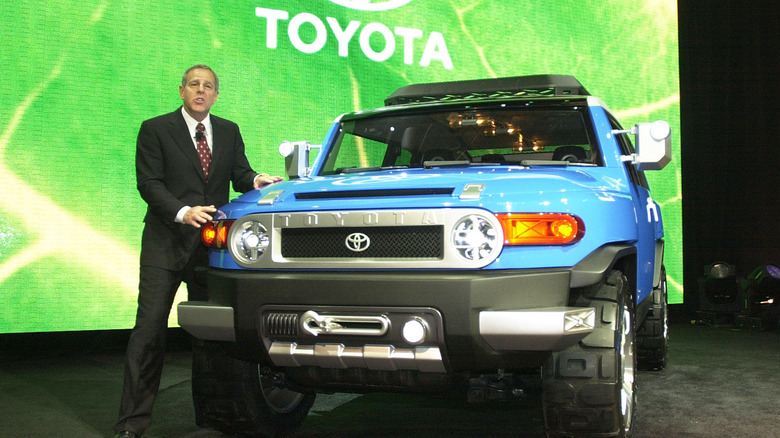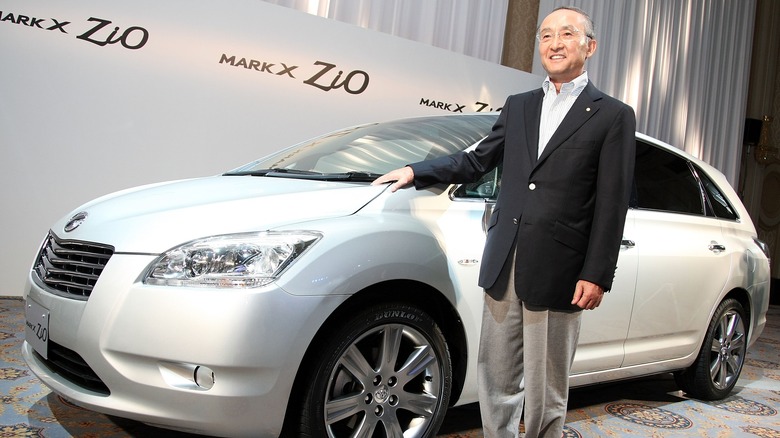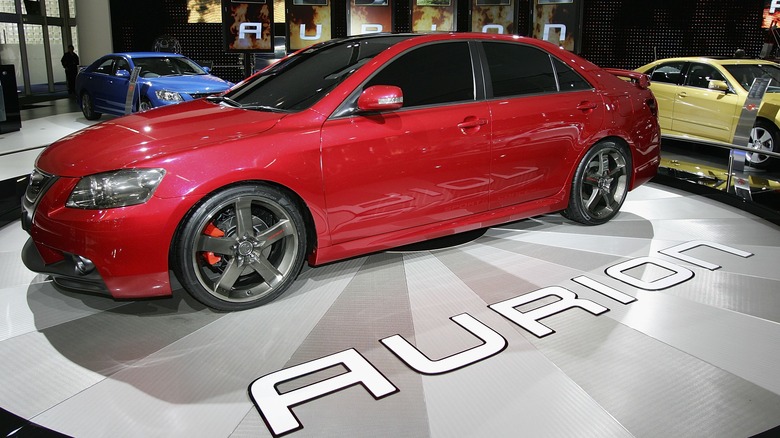5 Of The Coolest Toyota Concept Cars That Actually Made It To Production
Like any of the big manufacturers, Toyota has created its fair share of concept cars. In some cases, they were practical models intended to lay the groundwork for a model or vehicle family that would later be produced. Others were a bit more outlandish. Who could forget that ludicrous highlight of the Tokyo Motor Show in 2011, the Toyota Fun-vii, which was referred to as a "smartphone on wheels" and looked like a gigantic old-school computer mouse? The world would have been a more wonderfully ridiculous place if the Fun-vii had reached production, but it never did. However, several Toyota concept cars, whether through original intent or with a dose of serendipity, did.
There have been some strange Toyotas that made it to the market and some other incredible concept cars that should have been made but weren't. From the Toyota Porte to the TRD Aurion, here are some of the coolest Toyota concept vehicles that actually made it to production.
Toyota Porte
First revealed in October 2003, Toyota's NLSV, or New-Life Support Vehicle, had a name that gave it something of a medical air, but in reality, the vehicle was anything but. Promotional materials from Toyota declared that the model was all about roomy luxury, with "a voluminous flat-floor interior [that] lets you travel with living-room-like comfort." Decked out in a smooth grey and yellow material, the concept car felt like a swanky living room inside, too.
With room for five, wireless doors and a floor standing at just under a foot, Toyota wasn't kidding with its living room-esque claims. This seems to have been envisioned as something of an extension of the owner's home as much as it was a vehicle. Naturally, this wouldn't be something all Toyota customers would want in a new ride, but the company had enough faith in the concept to bring it to market.
This concept car went into production as the MPV Toyota Porte. First released in 2004, the mini vehicle retained the passenger sliding door and boasted either 86 horsepower in its 1.3-liter engine or 107 horsepower as a 1.5 liter. A 2012 redesign further emphasized the versatility of the model family, with everything from sizeable compartments to hooks for storage.
FJ Cruiser
Toyota showed off the FJ Cruiser concept at the Detroit Auto Show in 2003, and it wouldn't be long before it became a retail reality. Car And Driver quotes the vehicle's designer Jin Kim as explaining that the model "takes on an authentic functional form, yet adopts several styling cues from the original FJ." Toyota has extensive experience in the realm of land cruisers, having developed its first in 1950 (as a transport for the National Police Reserve Forces of Japan). More than a half century later, the manufacturer wanted to determine whether a new model, harking back to the classics but with new aspects all its own, was in order. The answer seems to have been in the affirmative.
The FJ Cruiser was released for the 2007 model year, with a 239 horsepower V-6 with a four-liter capacity. In a first drive review, Car And Driver declared itself "sufficiently impressed" with the model's "refined street manners, obvious build quality, and amazing versatility." The model family would continue to be created in Japan for many years until it was discontinued in December 2022.
Mark X ZiO
A minivan isn't typically regarded as the most aesthetically pleasing or sleek vehicle. However, the FSC concept car challenged this conception in offering a vehicle Toyota referred to as "a new-category vehicle model that evolves and combines the elegance of a sedan and the utility of a minivan." The name, which stands for Flexible Saloon Concept, is a reference to the hybrid nature of its design. As unveiled at the 2005 Tokyo Motor Show, it featured some intriguing elements, including a futuristic look and foldaway passenger seats.
The FSC would later be amended and released as the 2007 Mark X ZiO in Japan. Heavily based upon the FSC, the family featured seating for up to seven, and some seats could be removed to make more space. It was this feature that gave the machine its title, ZiO (Zones in One). Available at up to 280 horsepower (via a 2GR-FE engine), it was manufactured until the 2013 model year. (The model pictured was revealed in 2007.)
Toyota Alphard AH20
Arriving two years after the FSC concept, the FT-MV seemed to take certain cues from the FSC with a similarly subtle paint scheme and overall look. Aside from its harsher exterior angles, the primary thing that set the FT-MV apart was its seating options. Passengers in the second row, Toyota boasted, could enjoy "fully automatic ottoman style."
That ottoman concept was made into a reality with the release of the Toyota Alphard AH20. This is the second generation of the Alphard, the first of which was introduced in May 2002. A new family member, the Toyota Vellfire, was also introduced along with the AH20 in 2008. The Vellfire sported a distinctive aesthetic and the choice of a 2.4- liter or 3.5-liter engine. In June 2023, Toyota announced the arrival of its fourth-generation models, which sport improved fuel efficiency and double wishbone suspension. The Vellfire Z Premier version also had jet-black painting and a slick trim that aims to blend practicality with style.
[Featured image by Dinkun Chen via Wikimedia Commons | Cropped and scaled | CC BY-SA 4.0 ]
TRD Aurion
In 2006, Toyota had ideas brewing for sports car developments and introduced some of them at the Australian International Motor Show that year. One of them was the Toyota Aurion Sports Concept.
A bright red model with black accents , it diverged from prior models by featuring twin exhausts and mysterious darkened glass windows. Autoblog quotes Toyota Style Australia Manager of Styling and Design Paul Beranger as stating that such features were "likely to appear on production vehicles that go beyond Aurion's new sports range, the Sportivo SX6 and ZR6." He also said the Sports Concept was "a vision for the future styling direction of Toyota Australia's sports-car image."
The TRD Aurion, essentially, was the production model of the Sports Concept with its speedy launch a year after the show. Though it's not the most unique of designs, this latest Aurion had significant specs, with a top speed of 155 mph, 323 horsepower and a Twin Vortices Supercharger. Though perhaps not among the best Toyotas ever designed, it remains a notable model.





